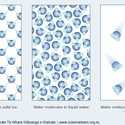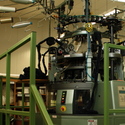Solar energy is transformed into other energy forms for our use on Earth – energy for food (chemical energy1), electrical energy and heat energy2.
Food
Solar energy3 (sunlight) is crucial for our survival on Earth. Sunlight (visible light) falls on the leaves of plants where a process called photosynthesis4 takes place. The energy (red and blue light) that plants absorb from the Sun is the energy supply for the building of simple sugars that are then converted into starch5 for storage. The plant can then use this energy store to grow. When we eat plants, the stored chemical energy from the plant is transferred to us. This provides us with an energy store for all our life processes such as growing, moving, making sounds and breathing. All life is dependent on the Sun’s energy.
Electricity
Just as solar energy is transformed to a useful form of energy in plants and animals (through the food chain), scientists have discovered that we can also convert solar energy into electrical energy (electricity6) for our needs.
There are at least 2 ways currently used for converting solar energy into electricity:
- Solar (photovoltaic) cells are used to convert solar light energy7 into electricity.
- Concentrating solar power (CSP) allows a large area of sunlight to hit a trough where solar collectors (lenses, mirrors and tracking systems) concentrate it into a beam that boils liquid in order to make steam, which moves turbines to make electricity.
Using solar energy for electricity is environmentally friendly. It does not produce greenhouse gases8 or other atmospheric emissions. The major component for this power generation is just sunlight. Using this power source means we can reduce our use of fossil fuels9, which are a limited resource.
With new technology, bright sunlight is not needed to generate electricity from solar energy. Solar cells can work on gloomy days if the temperature10 is moderate.
Solar energy can be used to supply electricity in underdeveloped countries where there is no access to electricity but there is an abundance of sunlight (such as some African countries). Solar power generation facilities can be set up to provide electricity for a whole village.
Heating
Scientists have found that dark coloured objects become warmer than light coloured objects in the Sun. This is because dark colours absorb more light energy. The light energy from the sun causes the particles of the object to vibrate, transforming the light energy into heat energy11. The heat energy is then radiated out as infrared12 light. The article Heat energy explains these processes in greater detail.
Dark objects heat13 up and cool down faster than light coloured objects because they are better at absorbing and radiating infrared light. Materials that are not good at absorbing visible light will reflect it away again. This is why these objects appear as light colours. Light coloured objects then reflect most of the light energy and therefore are cooler than darker objects.
Passive heating is when the Sun warms objects with no extra help. The Sun warms buildings through the roof, walls and windows in this way. Buildings in cooler countries are often designed to face the Sun to trap a lot of solar heat energy. Painting the walls dark colours or black make the surfaces very good at absorbing light to produce heat energy. In hot parts of the world, people paint their houses white or other lighter colours to reflect solar energy to help keep their houses cool.
Water can be heated using solar energy. This is done through solar collectors. Solar collectors trap and absorb the Sun’s energy. Generally, the solar collector14 has three layers. The first layer is a see-through layer that lets in the Sun’s rays. The bottom layer is painted black to absorb as much solar energy as possible (which is then radiated as heat energy). In between these layers are pipes filled with water that are warmed by the radiated heat energy. The pipes then conduct the heat energy to the water. The heated water might be used for household needs, to heat the interior of the house (through insulated piping) or for swimming pools.
Heat energy can also be collected using large arrays of mirrors as solar collectors. Some industries in the world (refining metals and firing ceramics, for example) use mirrors to focus sunlight on an oven or furnace. Temperatures from these ovens have yielded more than 3,300°C.
Nature of science
Scientists need to explore future energy needs. Unlike fossil fuels, solar energy will never run out and it’s free – a sustainable15 option to be developed as an energy source. Scientists are often ‘forced’ to investigate certain areas of science because of need.
Activity ideas
Students can explore the transformation to heat energy through these hands-on activities Using heat energy, Exploring solar power and Making a solar oven.
The activity Māui and the Sun uses the Māori legend to introduce the concept of harnessing the Sun as solar energy.
Additional teacher resources include Alternative conceptions about energy and a unit plan.
- chemical energy: The energy store in a substance that can be converted to other forms by chemical reaction.
- heat energy (heat): Heat energy: the transfer of energy in materials from the random movement of the particles in that material. The greater the random movement of particles the more heat energy the material has. Temperature is a measure of the heat energy of a material.
Heat: the flow of energy from a warm object to a cooler object. - solar energy: The energy received by the Earth and from the Sun. Also called solar power.
- photosynthesis: A process that uses the energy from sunlight to convert carbon dioxide and water into carbohydrates, releasing oxygen as a byproduct. Photosynthesis occurs in the green parts of plants, in algae and in some microorganisms.
- starch: A complex carbohydrate found chiefly in seeds, fruits, tubers, roots and stem pith of plants. Commonly found in foods, such as potatoes, wheat, rice and corn.
- electricity: A general term that includes a variety of phenomena resulting from the presence and flow of electrical charge.
- light energy: Electromagnetic radiation, particularly radiation of a wavelength that is visible to the human eye.
- greenhouse gases: A natural or manmade gas that traps heat in the Earth's atmosphere and contributes to the greenhouse effect. The main greenhouse gases are water vapour, carbon dioxide (CO2), methane (CH4), nitrous oxide (N2O), ozone and industrial gases such as chlorofluorocarbons (CFCs). These gases in the Earth's atmosphere trap warmth from the Sun and make life possible. An overabundance of greenhouse gases leads to a rise in global temperatures – known as the greenhouse effect.
- fossil fuel: Materials such as coal, oil and natural gas formed from the fossilised remains of plants that lived many millions of years ago. Often burned as fuel – although this releases large amounts of CO2, which contributes to global warming. Fossil fuels are also not renewable – there is a limited amount.
- temperature: A measure of the degree of hotness or coldness of an object or substance. Temperature is measured with a thermometer calibrated in one or more temperature scales. Kelvin scale temperature is a measure of the average energy of the molecules of a body.
- heat energy (heat): Heat energy: the transfer of energy in materials from the random movement of the particles in that material. The greater the random movement of particles the more heat energy the material has. Temperature is a measure of the heat energy of a material.
Heat: the flow of energy from a warm object to a cooler object. - infrared: Invisible electromagnetic radiation with a wavelength between approximately 0.75 micrometres and 1 millimetre. Infrared occurs between the red end of the visible light spectrum and microwaves. All things over a certain temperature (absolute zero) absorb and emit infrared radiation. Infrared radiation and observing technologies are used in many industries from medicine to finding people buried under rubble and by the military and others in night-vision goggles.
- heat energy (heat): Heat energy: the transfer of energy in materials from the random movement of the particles in that material. The greater the random movement of particles the more heat energy the material has. Temperature is a measure of the heat energy of a material.
Heat: the flow of energy from a warm object to a cooler object. - solar collector: A device that absorbs and accumulates solar radiation for use as a source of energy.
- sustainable: A way of using natural products so they are available for future generations.











